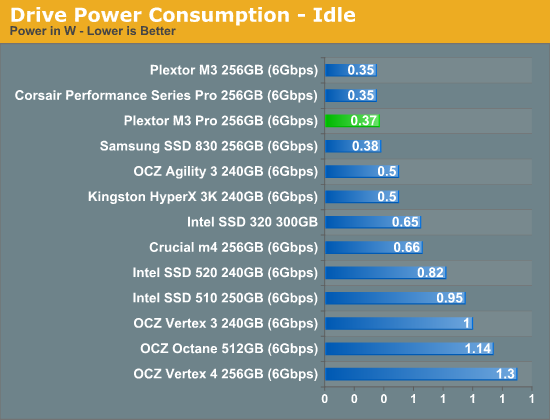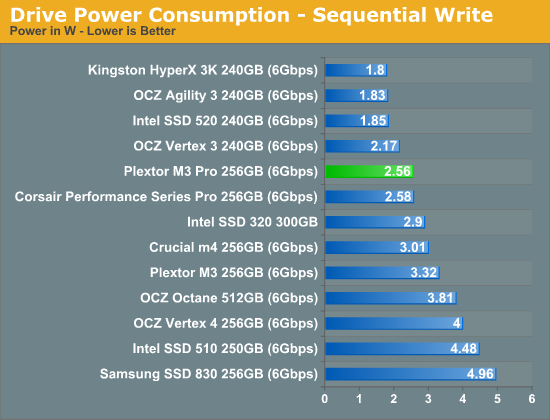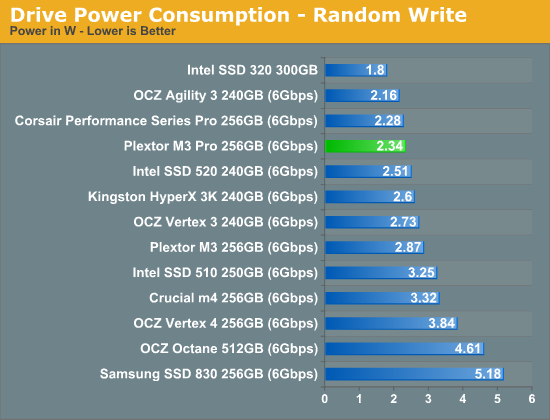Plextor M3 Pro (256GB) Review
by Kristian Vättö on July 1, 2012 1:45 PM ESTPower Consumption

Idle power consumption is a little higher than the M3 and Corsair Performance Pro, but still much better than what most other drives offer.

Power consumption during sequential writes, on the other hand, is noticeably lower than the M3. Here the M3 Pro is on-par with Corsair's Performance Series Pro.

Random write power consumption follows the sequential write pattern—the M3 Pro is again more efficient than the M3 and almost equivalent to Performance Pro.
I would like to note that the power used during I/O actions is only one aspect of total power consumption. If you have a fast drive, it will obviously complete I/O tasks quicker (some might be familiar with the term "race to idle") and hence spend less time writing/reading and more time idling. In terms of laptop battery life, idle power consumption is the most important aspect, although it does depend on one's workload. We are working on improving our power consumption tests in order to make them more real world relevant, but at least for now it looks like the Plextor M3 and M3 Pro should do quite well in a laptop.










55 Comments
View All Comments
Coup27 - Sunday, July 1, 2012 - link
I agree. I welcome another SSD toolbox into the mix, but with its current feature set, it is largely pointless. Manual TRIM for a toolbox utility is essential.I presume that Samsung make Toshiba's NAND for them? I did not know that.
Kristian Vättö - Sunday, July 1, 2012 - link
Samsung and Toshiba both make their own NAND. Toshiba does have a joint venture with SanDisk though (similar to what Intel and Micron are doing).Coup27 - Monday, July 2, 2012 - link
"The NAND is once again from Toshiba and there are a total of eight NAND packages on the PCB. These are 32GiB quad-die packages and are manufactured using Samsung's 24nm process"I don't understand this then?
Kristian Vättö - Monday, July 2, 2012 - link
That's a typo/error. Fixed now :-)csroc - Sunday, July 1, 2012 - link
At least the author knows who Plextor is this time!pheadland - Sunday, July 1, 2012 - link
OCZ also has an SSD toolbox, and it more functionality than the Plextor one.Belard - Monday, July 2, 2012 - link
Last time I checked... its just a ROM/FIRMWARE upgrade tool.Hence, I buy and tell friends to get Intel drives. I'll gladly pay the extra $20~30 for the reliability, support and upper-class performance. Sure its NOT #1, but I'll take a slight performance hit over BSODs and full out failures.
I had to explain to a client his SSD that Dell installed in his high end Dell is a Samsung that doesn't support TRIM... its new enough to be SATA3/6Gbs - and yet its performance is already SLOWER than my own intel G2 M25 drive (SATA 2).
The Intel tool box if full featured. 3.0x is quite nice.
KAlmquist - Sunday, July 1, 2012 - link
I ask because the write performance of SSD's can vary a lot depending on how full the drive is. The Vertex 4 even uses a different block allocation algorithm if the drive is less than half full.Kristian Vättö - Sunday, July 1, 2012 - link
Storage Bench is run on a clean drive.KAlmquist - Monday, July 2, 2012 - link
So it measures how the drives perform when they have a lot of free space. Thanks.